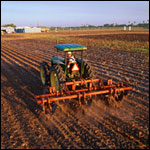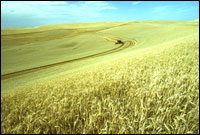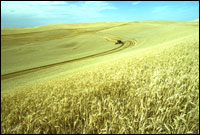
Against the Grain
By Richard Manning,
North Point Press,
232 pages, February 2004
What’s for dinner at your house? Unless you’re a strict Atkins adherent, chances are you’ve got at least one of the world’s four top crops on your plate. Corn, wheat, rice, and potatoes account for about two-thirds of the world’s nourishment; from French fries to brown rice, these familiar starches dominate humanity’s diet.
Therein lies the problem, says journalist and author Richard Manning. In his new book, Against the Grain: How Agriculture Has Hijacked Civilization, Manning argues that the cultivation and commodification of these humble carbs has caused ecological destruction, social inequality, starvation and — in the era of McDonald’s — obesity. And that’s just the beginning. Over the past 10,000 years, he writes, humanity has struck a “bitter bargain,” giving up “a large measure of our sensual lives for the bit of security that comes with agriculture.” Because of agriculture, he argues, we’ve lost much of our connection with the undomesticated. While our hunter-gatherer ancestors were able to observe and absorb the subtleties of the natural world, our senses have been dulled by the sedentary life.
Most environmentalists are already familiar with critiques of industrial agriculture; volumes have been written about the environmental and social evils caused by pesticide-doused monocrops and corporate-controlled megafarms. Manning revisits this territory, but with a grander purpose. He argues that the practice of agriculture itself — the domestication and cultivation of food crops — has inexorably led to the problems of industrial agriculture and, by extension, to many of the ills of the modern world. “I have come to think of agriculture not as farming, but as a dangerous and consuming beast of a social system,” he writes.

Ill-gotten grains?
Photo: USDA.
Of course, agricultural civilizations and their sedentary ways also led to the rise of the written word, so Manning’s audacious claim strikes at the source of his own job — and, in a larger sense, the very structure of our lives. The question “Why agriculture?” he concedes, “is so vital, lies so close to the core of our being that it probably cannot be asked or answered with complete honesty.”
Nonetheless, Manning is willing to give it a shot, and he starts by tossing off a provocative overstatement: “Gamboling about plain and forest, hunting and living off the land is fun. Farming is not. That’s all one needs to know to begin a rethinking of the issue.” Fortunately, most of his arguments are quite a bit more measured. Over the course of the book, he picks apart many of our deepest assumptions about the basic “goodness” of agriculture, giving us a much more sour perspective on one of humanity’s most basic institutions. This is our pastoral myth, served sunny-side down.
Manning cites evidence that hunter-gatherers were significantly taller and healthier than their pastoral brethren; only in the modern era have North Americans started to regain the stature of their hunter-gatherer ancestors. The skeletal remains of hunter-gatherers in central California, he says, led one anthropologist to remark that they are “so healthy it is somewhat discouraging to work with them.” Life on the move may have been uncertain, says Manning, but it often yielded a varied, vitamin-rich diet not available to most agricultural societies.

A tough row to hoe.
Photo: USDA.
Although the spread of domesticated grains and other crops created a wealthy upper class, Manning points out that it also created an underclass. Most members of early agricultural societies suffered from physical deformities caused by backbreaking labor, chronic malnutrition, disease, and often enslavement. “We have no clear examples of colonized hunter-gatherers who willingly, peacefully converted to farming,” Manning writes. “Most went as slaves; most were dragged kicking and screaming, or just plain died.”
In the millennia that followed, agriculture fed its own growth, producing larger populations that demanded the cultivation of more and more land. Inevitably — and frequently, Manning argues — runaway population growth led to ecological and human disaster: “Famine was the mark of a maturing agricultural society, the very badge of civilization.” He traces the cyclic food shortages in Asia and Europe, giving detailed accounts of modern famines in China and Ireland.
By the middle of the 20th century, Manning writes, this agricultural expansion “ran up against the limits of the planet’s supply of plowable land. From that point, almost all the increases in total food production have had to be achieved by increasing yield — by harvesting more bushels per acre.” The Green Revolution — the development and international spread of intensive farming techniques — broadened and deepened agriculture’s impacts on natural systems. Heavy fertilizer use has dumped nitrogen into rivers, wetlands, and oceans, depleting oxygen and creating “dead zones” throughout the world’s waters. Widespread erosion, salinization, and other woes can also be pinned on modern agricultural practices, and the massive energy requirements of agriculture have made oil companies “part of the farm lobby.”

Field of screams?
Photo: USDA.
The social impacts of industrial agriculture have been just as pernicious, argues Manning. Political realities have led to more and bigger subsidies for agribusiness, shoring up powerful companies like food processor Archer Daniels Midland. U.S. grain surpluses are dumped on developing countries, putting legions of farmers in poor nations out of work and widening the global gap between rich and poor. The United States’ federal nutrition policies have long favored surplus harvests over healthy food, contributing to widespread obesity. “Industrial agriculture grows commodities, not food,” he writes. “The fact that commodities do not meet our bodies’ needs is irrelevant.”
That may sound like the seed of a conspiracy theory, but Manning emphasizes that originally, at least, there was no malevolent plan driving the development of agriculture. Despite its many and dire consequences, he says, agriculture was not a “mistake made by humanity.” It arose independently throughout the world, each time a few clever hunter-gatherers encountered some easily domesticated wild plants. The larger populations created by agriculture survived by spreading the practice — and spreading its problems.
Though Manning might like us to survive solely on hunting, fishing, and gathering (he writes glowingly of his own hunting expeditions on his parcel of land in Montana), he admits that we’ll never abandon agriculture completely. Still, it’s a surprise — and a disappointment — when Manning turns back to agriculture itself for solutions. He speaks of the sensual pleasures and ecological benefits of eating fresh food from local farms, and describes the work of pioneering local-food chef Alice Waters and organic farmer Fred Kirschenmann, who directs the Leopold Center for Sustainable Agriculture. These crusades are worthy and daring in their own right, but they’re likely to be familiar to most readers. Manning may be trying to stick to the realm of the possible, but his radical analysis calls out for a correspondingly radical and unsettling vision of the future.
Even though Manning’s call to action falls short, his arguments still deserve attention. Agriculture may be with us for good, but it’s useful to consider where it’s gotten us, and where we might be without it. Like Blood Rites, Barbara Ehrenreich’s analysis of the origins of war, and Jared Diamond’s bestseller Guns, Germs, and Steel, Against the Grain‘s analysis of the distant past sheds light on modern problems. If, as Manning writes, “agriculture dug the tunnel of our vision,” this book may open an unnoticed window.


